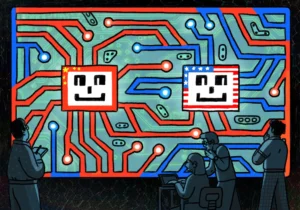image: Doris Liou
Today, The New York Times published a compelling article exploring the interaction dynamics between the Chinese Chatbot Ernie from Baidu and OpenAI’s ChatGPT. This amusing and informative piece certainly makes for an enjoyable read. Nonetheless, I want to emphasize that drawing conclusions about the relative capabilities of the two Chatbots or extrapolating these to the broader technological competition between China and the U.S. would be grossly premature.
This situation is comparable to watching two toddlers race and predicting who will win an Olympic gold medal two decades later, except, in the case of AI, the developmental timeline isn’t 20 years, it’s more likely to be 3-5 years.
Some individuals, perhaps not entirely versed in the history of AI, believe that the recent emergence of Generative AI tools such as ChatGPT and Google Bard signifies a leap in AI progression from the equivalent of a bicycle to the International Space Station. I’d argue that we’ve transitioned from the bicycle to the Model T. While this might seem less dramatic, it still represents a considerable leap. However, we should be ready for another significant jump in the near future. AI is expected to advance from its current “Model T” stage to the “Space Station” equivalent within the next few years. The effects of this transition will be far more impactful on our personal and organizational lives than most of us can currently fathom.
Keep an eye out for future posts, where I’ll delve deeper into the probable impacts of these advancements and provide guidance on how to prepare for them!
Read more here: https://www.nytimes.com/2023/07/14/business/baidu-ernie-openai-chatgpt-chinese.html?smid=nytcore-ios-share&referringSource=articleShare
